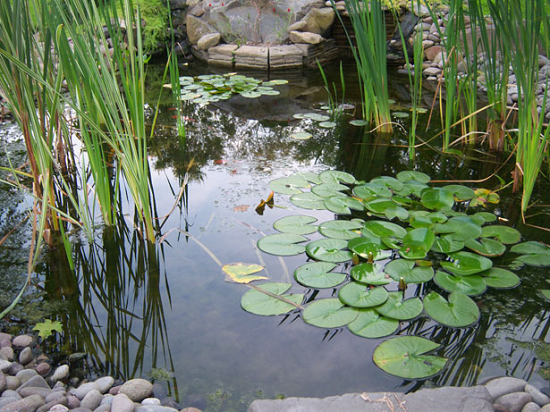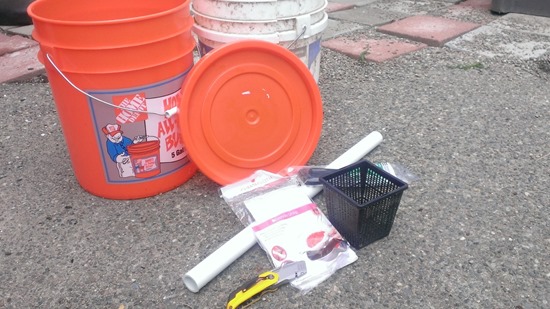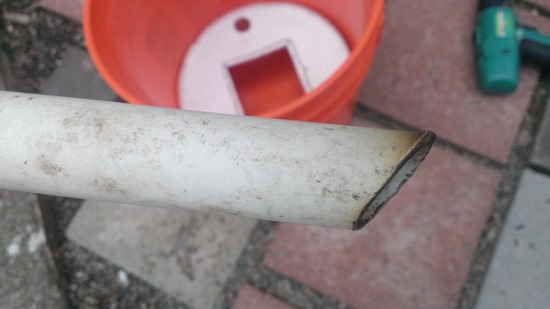Recent Articles
Building Your Own Pond
10.9 years ago fish poop, guest post, water 1 Comment

So you want to build a pond in your garden? There is a right way and a wrong way to go about it. First, you have to pick the area in your yard that will be a good fit. In order to do that, you have to know where all of the underground utility pipes are located. Whether it is water, electrical or cable, you don’t want to hit any of them when you start digging. You utility companies will be happy to come out and mark the locations to prevent any mishaps.
Next, you want to decide how large you want the pond and make sure it is not near a lot of trees. The leaves will clog it up and make a lot of extra work for you. An average pond is two to three feet deep. Unless you plan to put Koi in it, it will need to be three to four feet deep. Even if you decide against the Koi, it is always best to make sure you have running water to keep the mosquito population down. A simple pond pump will help ensure that the water is always moving.
You can easily find reading on how moving water makes a pond environment much healthier for plants and fish. To find ways to keep your water in motion see more info on pond pumps and water systems.
Now comes the time to go get your supplies. You can buy either a preformed or flexible liner for your pond. A flexible one allows you to determine the shape and size and are relatively easy to work with. You can build your pond with common garden tools; there is really no need to have heavy machinery, unless it is going to be a very large pond. You will also need sand to spread around before you put down your liner. This prevents tears from happening due to rocks and roots. Just spread it evenly and as thick as you can to be safe.
Make sure you get the rocks you need to line around the outside and to build a waterfall should you decide you want one. Most hardware stores will deliver them, so you shouldn’t need a truck. Don’t forget your water plants and decorative plants for around the pond either.
Not everyone has a yard or the space to build a pond. However, do not be discouraged, because you can still have a water garden by using a sealed decorative container. Just put rocks on the bottom and choose what water plants you would like to have. Once again, you will have to do something to prevent mosquitoes, even if it is only a small water garden. They will breed in any standing water. Either the water has to move, or you need goldfish to kill the larvae.
A pond can bring a lot of joy to you and your family. They are very calming and soothing to sit next to after a hard day at work. Especially those with the gentle sounds of water flowing over rocks. You’ll be surprised at how good it is for relaxation and even meditation.
Gnomes in the garden
10.9 years ago Uncategorized Leave a comment

Pretty awesome Ikea commercial involving gnomes, fortunately for me I just have one gnome and he is always sleeping.
Latticework that Works!
10.9 years ago guest post, pests, rabbits, vegetables, vertical gardening Leave a comment

Lattice fencing has been a go-to tool for gardeners forever. Its classic crisscross or grid structure has remained unaltered since its inception for one reason: it works! And as we all know, if it ain’t broke, don’t fix it.
Indeed, the lattice is the one "fixing" things – it provides privacy fencing for yards, serves as a blank canvas for clinging vines and ivy, helps climbing vegetables to reach new heights, keeps out unwanted critters, and functions as the main building material for decorative arbors, trellises, screens, pergolas and more!
Let’s learn a bit more about lattice by delving into two of its main purposes: vertical gardening and natural pest control.
Vertical Vegetables

One of the wonderful things about the overlapping strips in latticework is the structural support they provide for climbing vines and vertically-growing plants and vegetables.
In the world of trellis climbers, you can’t go wrong with selections such as tomatoes, cucumbers, melons, peas and pole beans.
Once the frost threat passes for your region, lay out your garden in front of your lattice incorporating each plant’s specific spatial needs – this info can be found on the transplant’s nursery container.
After placing each transplant in its specified hole, cover with soil (mixed with compost for nourishment) and water liberally. From here, attach each of the climbers to the lattice by looping a soft piece of twine around the main stem of each plant and tie the loose ends to the lattice.
As the plant grows, the twine will guide the stems to grow vertically against the lattice. As soon as the vegetables ripen, harvest them and enjoy a homegrown bite of your hard work!
Natural Pest Control
Another fantastic use for lattice is as a tool for border control for those annoying animals that threaten to move into your home, completely uninvited. Just take a look around at all of the crawl-space homes surrounded with lattice under-fencing and you will understand the widespread infestation issues that lattice solves in such a lovely manner!
But more to the point is how to keep hungry critters like rabbits and deer from feasting on the fruits (and vegetables!) of your labor: installing lattice fencing is a great way to keep their grubby little paws off your peas and carrots and little hooves away from your rose bushes.
Although a picket fence works well as an exterior border surrounding your entire yard, if it is not at least 6 feet tall it may not thwart all deer, as some can clear that height in a single leap. Rather than installing a completely new fence, consider adding a level of lattice at the top of your existing fence.
Attaching a length of lattice to the upper railing of your fence not only provides the additional height to keep the deer at bay but it also adds texture and interest to your fence and can soften the entire look of your yard if you allow vines or ivy to grow on the lattice. Plus, you are repurposing what you already have which is a great way to save some green for the planet and your wallet!
When it comes to rabbits, here’s a quick tutorial on installing a lattice border around your garden:

You’ll need:
- Wire rabbit fencing, with openings no larger than an inch: Ensure you have enough wire for the length of your entire garden area that is at least four feet wide
- Decorative lattice, in the same length as the wire fencing and at least three and a half feet wide
- Garden trowel
To build your border:
- Use the garden trowel to dig a narrow channel around the perimeter of your garden, approximately 12 inches deep
- Bury the wire rabbit fencing in the trench – there should be 12 inches below the surface and three feet above ground
- Fill in the trench halfway, leaving six inches of space from the surface
- Enclose the wire rabbit fencing with the lattice, burying the lattice approximately six inches deep
- Replace the remaining soil and firmly pack the ground around the new fencing
With this type of border, you have form and function. The decorative lattice masks the presence of the wire rabbit fencing, at least partially, and cursory garden admirers may not even notice it, depending on the style of lattice you choose. By burying the fence in the ground, you discourage burrowing and digging and at three feet tall, even Bugs Bunny will have difficulty breaching your barrier!
What other garden projects do you plan to complete with lattice?
Chris Long, a long-time store associate at a Home Depot in Illinois, writes for the Home Depot website. He enjoys writing on outdoor projects ranging from lattice to lumber and fencing.
How to make a self watering planter with a 5 gallon bucket
10.9 years ago Uncategorized 2 Comments

Container gardening can be an excellent way to take advantage of normally unusable space on your patio or garden. The main problem I have with container gardens is they can dry out very quickly and for plants like tomatoes and cucumbers this can be a quick death for your plants, my solution to this was to build a self watering planter using just a few tools and a 5-gallon bucket and lid.
Materials for 5-gallon bucket self watering planter:

- 5 gallon bucket with lid
- Another 5 gallon bucket busted one like mine is fine (optional)
- 1.5 feet of 3/4 in PVC pipe (other sizes are ok but aim will have to be better for smaller sizes when watering)
- Utility knife
- 4 inch net pot
- cheese cloth
- Jig-saw (optional but speeds things up)
Construction for 5-gallon bucket self watering planter:
Step 1: Make hole for net pot. I started by tracing the pot on the bottom of my broken bucket.

Obviously if I cut on this line I drew the net would fall right in so a freehanded a line inside with about 1/4 inch in and cut it out with a utility knife. I chose a square net pot since straight lines are much easier with a knife but if I would going to make a half dozen of these things I probably would get a good hole saw and use some round net pots.

Step 2: Cut bucket to size. For the desired height of the net pot in the reservoir I found that cutting the bottom of the bucket to 2.5 inches was perfect for me. Now you can definitely to this with a utility knife, but a jig saw can make the job much quicker.

Step 3: Put some pieces together. Now place the recently cut bucket bottom side up into the other bucket and push down until it is firmly in place. Then drop in the net pot.

Step 4: Add watering tube. I decided to cut the bottom of the tube at an angle to ensure that water flow was not blocked when pushed to the bottom (especially if some sediments starts to build up on the bottom. I also used a hole saw to make sure I had a nice clean circle though this could be done with a utility knife as well with a little patience.

Drop the filling tube in the hole and you are almost ready to start filling the planter with soil.
Step 5: Finishing touches. I decided to add extra holes to enable some additional aeration from below.

To reduce soil from sneaking into the reservoir I lined the bottom with a couple layers of cheese cloth as a bit of a filter.

Finally I added a overfill hole approximately 1/4 of an inch below the top of the net pot. This will prevent the plant from getting too much water and also allows a gap of air to exist between the water and the plant for additional aeration.

Step 6: Getting planter ready for plants. Now it is time to to fill the planter with potting mix. If you are using organic fertilizer like myself I added some to the mix and combined well in the bucket. If you are using conventional fertilizer you will want to add a ring on the top of the soil around the perimeter of the planter. This will ensure you do not shock/burn the newly added plants when they are added.
Next you should top the planter with some plastic. This will keep weeds from getting in your soil but also help prevent water loss from evaporation. You can use a dark color to provide some additional heat for something like peppers, but given I was planning on planting some cucumbers I went with white plastic which I conveniently reused from the bag the potting mix came in. And secure it in place with the bucket lid where I removed the middle quickly with a utility knife. Note: Don’t throw away the middle if you don’t have an extra bucket to sacrifice for a planter, with some minimal support (PVC pipe and zip ties this could be used as the bottom of a planter.

Step 7: Time to plant. Start by cutting an X in the plastic to allow enough room to add you plant to you planter.

Finally drop in your plant and add water till you see water coming out of the overflow and enjoy your harvest to come with out having to worry about watering your container plants a couple times a day.

Just for fun when watering I did get some water on the plastic and poked a small hole where the water was piling up. This will prevent having some standing water when it rains but also provide some free water to the reservoir.
So if you have little/no ground to plant or more like me and just get absent minded to water frequently for about $5-6 in parts and about 15-20 minutes of work you can make your own self-watering planter.
Smart Garden Tools Need Smart Storage
10.9 years ago garden maintenance, garden planning Leave a comment

There’s nothing more gratifying on a sunny winter’s morning than going to the basement or garage and stepping on a rake. Yes, the joy of watching that well-worn hickory handle swing up and catch you right in the coffee cup (and then the nose) is an experience underappreciated by those who don’t garden. But what really makes the experience is dumping that hot coffee onto one of your expensive circuit boards.
There’s nothing more gratifying on a sunny winter’s morning than going to the basement or garage and stepping on a rake. Yes, the joy of watching that well-worn hickory handle swing up and catch you right in the coffee cup (and then the nose) is an experience underappreciated by those who don’t garden. But what really makes the experience is dumping that hot coffee onto one of your expensive circuit boards.
Of course, that’s all purely facetious. Unfortunately, it can be all too real for some of us who lack good storage space for our off-season garden needs – many residents in warmer, seasonal cities like Cincinnati struggle with effective organization and protection for their garden equipment. For most of us, the only climate controlled storage we have is where we store ourselves–the ol’ hacienda.
Shovels, cultivators, chemicals, and our own array of homemade tools accumulate quickly and have to go somewhere. Plus, most people don’t want all those items underfoot for several months a year. So in general, we find a rain-resistant place to store everything outside, and maybe do a little rehab work come spring.
However, the smart gardener today uses the thinker as much as the tiller. Greater technology in irrigation management, temperature monitoring, and humidity observations means that, at season’s end, we now have some very expensive and fragile equipment that needs someplace to go until the first light of spring.
Scientific instruments like these can tolerate significant meteorological swings. Store-bought ones will include advice on acceptable temperature and humidity ranges. Those you’ve made at home will provide that information on the individual components you’ve bought. And even within their accepted ranges, they all have issues with calibration.
Your hand tools shouldn’t be, well, left out in the cold either. You may have hundreds of dollars’ worth of them, shivering in the December chill like Washington’s troops crossing the Delaware. Keeping them in a warm place preserves your investment for the long haul.
Your power equipment needs good care as well. As smart as we garden now, we do still use the internal combustion engine quite a bit. These aren’t as sensitive to cold and moisture as electronics, of course, but the guts of your tiller do not fare well if your 2012 gasoline is still in there in 2013.
The best thing to do? You can buy gas stabilizer and pour it in the tank, or simply run the machine during its last use of the season until it is out of gas. You can till something, or just stand there and let it run. The same goes for string trimmers, mowers, pressure washers, and all gas-powered machinery.
Good climate controlled storage can also allow you to grow produce year-round, if you take a few steps to plan for it. Apart from the delicious outcomes, you will also find yourself in a horticultural state of mind all year. That makes you a more curious and creative gardener.
So take those cool fall days as the last vines are drying and organize some available space in your home to preserve your tools, nurture your plants, and protect your feet.



